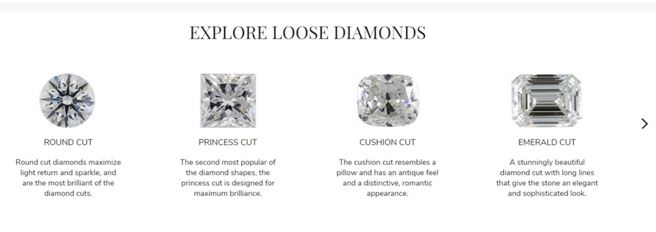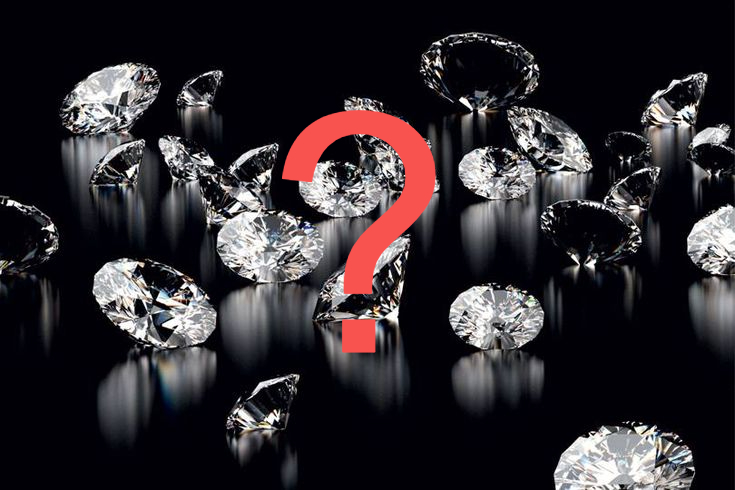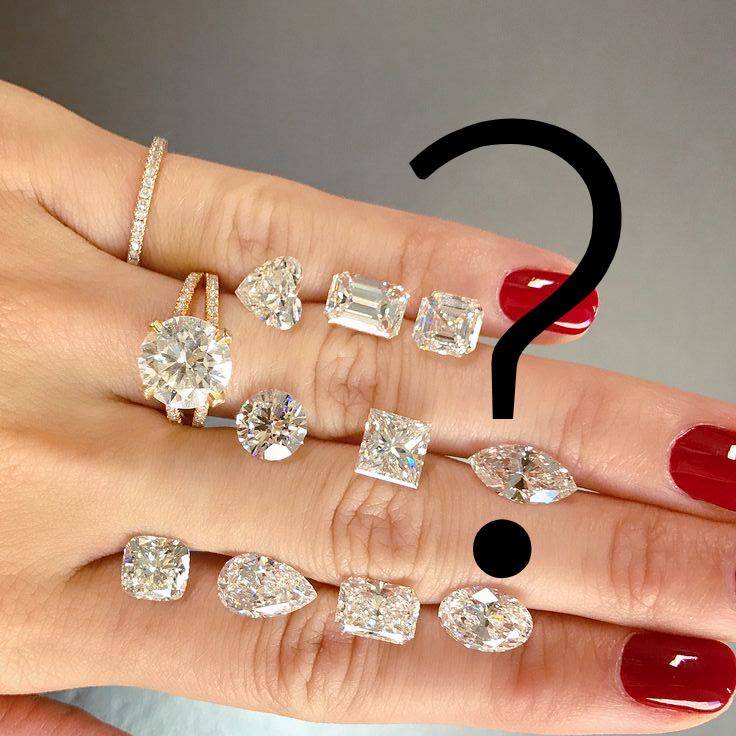Also referred to as the football-shaped cut, navette, eye-shaped cut, or the boat-shaped diamond cut, the Marquise cut diamond is a unique cut which is almost rarely seen in the world of engagement rings unlike other low vintage cut diamonds. These ascribed shapes are true of the marquise cut, in fact, the “navette” shape in French translation is “little ship” and is almost always used as a representative expression of all these shapes. It is also such a diamond that is classy to use and has a phenomenal shape that ignites many hearts. This is all thanks to its magical outlook which makes it appear so much like a smile. There are sure no qualms if it looks different to you! Although it is not often used for engagement purposes which are largely due to their dramatic appearance, they are a top choice in non-traditional weddings just because of that specific ‘navette’ look.
The marquise cut diamonds are not so much widely known as compared to the round or princess cut diamond but they are yet loved by many and are as such a treasured ingredient in their diamond collections. A lot of people are still yet to be fully in the know of how this diamond came about. Its history dates back to the eighteenth century in France when King Luis XV issued an order for a diamond cut to be made and must bear a striking resemblance to the Marquise de Pompadour lips, his betrothed. The cut was made as it was ordered and has since been referred to as the Marquise cut.
Major constituents of many prominent and royal people’s jewelry are widely known gemstones, especially in the 1400s. This marquise cut diamond is one of the many diamond cuts that have been fine-tuned and developed severally over time. Perhaps it is best to explain the shape of a Marquise cut diamonds as a diamond with a characteristics egg shape with pointy ends. As a result of the history and origin of this diamond cut, they are common in non-traditional engagements rings. With the Marquise cut diamond ring set, whenever you wear it, your finger appears a lot slender. This, of course, does not happen in the case of the traditional type of round stone cut. Marquise cut diamond is less costly as compared to other diamond cuts and as such popular and easily acquired. It implements the amount of weight in carat in a diamond and as such, it looks bigger than some others.
Since marquise cut diamonds are exquisitely lengthy and slim just as it is with the oval diamond, they have the tendency to form the illusion of a bigger dimension. In matters of carats, this cut diamond has one of the widest crown surface areas of any shape of the diamond. This all the more makes it a preferred pick when a buyer is looking to put the perceived size or appearance of a diamond to use.
Marquise cut diamonds features an extent of the bow-tie, ranging from being almost invisible to very severe degrees. This effect implies that when a light goes through the diamond, it projects a shadow across the facet of the diamond cut. The extent of this shadow can be minimized by changing the pavilion and modifying the angles of the facets as well as the tables to exquisitely disperse the illumination on the central region of the diamond. This bow-tie effect can also be seen in Oval, Pear and Heart shapes. The presence of a bow-tie effect is not easily checked just by going through the dimensions or certificate of the diamond, it can’t also be perfectly imagined. However, it can only be ascertained by physical and on-the-spot inspection.
FACETS
The marquise cut diamond comes with 58 facets and has an elliptical or oval shape with pointy ends. Although it cannot boast of the same reputation as some other diamond cuts, it can sure drive at almost the same level of competition with them. It features twenty-five (25) facets on the pavilion and comes with thirty-three (33) on the crown. However, the number of facets on the pavilion may vary within four (4) and eight (8). In addition, the shapes of this diamond cut are sometimes fashioned with a ‘French Tip’ which takes the place of the big bezel facet at the position with star and upper higher girdle facets.
In Pear and Heart figures, French tips are more often used. Although the optimum length to width ratio of this diamond cut is two to one, (2:1), it is often cut in traditional settings to ratios varying within 1.85 to 2.10 with respect to personal choice and disposition. A marquise-cut diamond is sparkling in all sense but it depicts a higher level of awesomeness when it has some other diamond cut options laced around it. This Marquise cut diamond is the choice cut by many and is the preferred pick by most women who think highly of how stunning it can be when spiced up with other available options that can be exploited for the ring set. The amazing thing about it is that the diamond cut can be placed in a ring such that the tips are point towards the finger in the vertical direction. It can as well be strategically placed such that the tip ends point on the finger in the horizontal orientation.
It is important to note when going for a piece of choice jewelry coming with a Marquise cut that the pointy ends have to be well secured. This is pivotal for the safety of the diamond cut because if the pointy ends are not well secured, it can easily get the diamond cut damaged and compromised. A good practice is to have claws built around the pointy ends of the Marquise cut to an appreciable extent. With prongs set around the two pointy ends, the Marquise cut diamond is protected from any possible tendency of chipping. For the fact that these points once closest to the external edge of the unrefined stone, flaws, and blemishes such as extra facets, naturals, and some other inclusions may be found in this region. But since there will be prongs and claws protecting these points, these flaws and blemishes are not easily seen as soon as the diamond is refined and set. However, the only thing you had had to worry about is if these flaws will be large enough to disturb the stability and firmness of the diamond, although this is just very rare and hard to come by.
Talking again about the bow-tie effect, it is important that you go for this diamond cut that has little to no bow-tie effect. It may be somewhat unavoidable to have a Marquise cut diamond featuring the bowtie effect but one of the many things you will be striving to achieve when making your purchase is to have your Marquise cut having a little to no bowtie effect. You sure don’t always want to have dark spots popping in the middle of your diamond cut.
LENGTH TO WIDTH RATIO
A key determinant in choosing the best length to width ratio is a lot based on your disposition and preference. Your personal choice should determine the extent of narrowness or wideness of your Marquise cut diamond. All in all, you are sure going to be keen on getting the diamond that looks strikingly stunning even to the bare eye and fits perfectly with your style and taste.
The more often used and popular length to width ratio falls within the range of 1.70 to 2.15. The length to width ratio is easily calculated by dividing the length by the width of a diamond. Take, for example, if the length to width ratio of your diamond is 6 millimeters and it comes with a width of 4 millimeters, then the ratio can be calculated to be 1.50
All Lumera Diamond comes with accurate measurements and precise length to width ratio, all these in a bid to help you be in the knowhow of the shape or outlook of the marquise cut diamond which you are looking out to purchase.
When it comes to going for the best Marquise cut diamond, symmetry also ranks high on the list of things to look out for. The two pointy ends should balance each other. Also, the left and right sides should align in such a way that they form an almost mirror image. If there should be the tiniest amount of misalignment at the ends, there can be a severe off shooting in the final set. This is the more reason why the need for a superb symmetry cannot be overemphasized.
With a length to width ratio of 1.75, a Marquise cut diamond is usually a bit stockier which may imply greater durability as compared to when the cut is coming with higher ratios. At 1.95 lengths to width ratio, a Marquise cut diamond will appear slimmer and maintain a minimal amount of stability. At 2.15 lengths to width ratio, a Marquise cut diamond will appear more elongated and maintain a lesser amount of durability as compared to others. In essence, no Marquise cut diamond shape is basically superior over another but the catch is to go for the one which gets your attention the most and ensure the cut Marquise is neatly cut and fitted into the jewelry.
CUT GRADE
The cut grade of a Marquise cut diamond is representative of the quality of the ratio and symmetry of the diamond. The GIA and AGS do not designate any cut grade to this cut but the however designate symmetry and polish grades. This thus makes Marquise cut’s grade to be determined by most retailers by its propositions, symmetry as well as its polish. This is because these parameters are good approximations of sparkle given that a true cut grade isn’t available.
Table% – Marquise’s cuts are considered poor, fair, good, very good, or excellent when they have their table percentage in the ranges < 50 or > 70, 50 or 69 – 70, 51 or 66 – 68, 52 or 64 – 65, or 53 – 63 respectively.
The depth percentage refers to how much light the diamond will reflect the depth percentage is indicative of the amount of light that the Marquise cut diamond will readily reflect. As regards the depth percentage, the cut is considered poor, fair, good, very good, or excellent when it has < 50 or > 74, 50 – 52.9 or 71.1 – 74, 53 – 55.9 or 66.1 – 77, 56 – 57.9 or 62.1 – 66, or 58 – 62 respectively.
When it comes to girdle, a very thin to a fairly thick one connotes an excellent and very good cut. It is good when it is within very thin to thick, fair when within very thin to very thick, and considered poor when the girdle is within very thin to an extreme thick parameter.
When the cut has no cullet, it is considered excellent. The cut is very good when it has very small cullet, good when it has small cullet, fair when it has medium cullet, and poor when the cullet falls any greater than medium.
COLOR
When it comes to examining color in this cut, it is best determined based on personal choice and individually biased. Be aware of the fact that most buyers may choose to go for the fairly warmer colors of the G-H diamond instead of the D-F type which is usually frigid colorless. Truth is that most Marquise cut with color on the extreme side and with high prices is usually steered largely by demand and supply. When customers are in dire search for the D-F color types, they are ready to pay more to get their hands on it. If the concept of color grading were not present at all, higher grade diamond will come at a lower premium price because the distinction between colors will be very hard to know. So, slight color differences will not be obvious and thus wouldn’t weigh at all on the scheme of things.
With Marquise cut diamonds that have larger size and surface area, i.e. above one (1) carat, the color may seem to look quite darker at the point ends. This is the exact reason why buyers usually decide to reach up to one step higher in color grade as compared to the rest kind of diamond cuts.
Check out the color descriptions below as a guide for examining and choosing your Marquise cut diamonds.
For less than 0.50 carats, the cut is considered excellent, very good, good, fair or poor if the color falls on D to G, H to I, J to K, L to M, or greater than M on the spectrum.
For 0.51 to 1.0 carats, the cut is considered excellent, very good, good, fair or poor if the color falls on D-F, G, H-I, J-K, or greater than K on the spectrum.
For 1.0 to 2.0 carats, the cut is considered excellent and very good, good, fair or poor if the color falls on D to F, G to H, I to J, or greater than J on the spectrum.
For greater than 2.0 carats, the cut is considered excellent and very good, good, fair or poor if the color falls on D to F, G, H to I, J to K, or greater than K on the spectrum.
When there is an absence of fluoro, the cut is considered to be excellent, very good if within faint to medium fluoro, good with strong fluoro, fair or poor when the fluoro is very strong.
CLARITY
Like color, dissecting the clarity of a Marquise cut diamond is usually very subjective. With the clarity grade made available by GIA, evaluating a Marquise cut diamond in terms of clarity has never been made easier. However, it is imperative to bear in mind that each customer will choose between clarity ranges based on personal standards and discretion. Some customers might be good with the Marquise cut diamond coming with inclusions so far it is not easily seen while others may not be okay with that or any sort of technical blemishes or flaws.
The following guide shows you what to check as regards the clarity of a Marquise cut diamond, especially when looking to make a purchase.
A less than 0.50 carat Marquise cut diamond is excellent if it has its clarity around FL to VS2. It is considered very good, good, fair or poor if it has its clarity on SI1 to S12, I1, I2, or greater than I2 respectively.
For 0.51 to 1.0 carat Marquise cut diamond, it comes as an excellent choice if it has FL to VS1 clarity. If the clarity is VS2 to SI1, SI2, I1 to I2, or greater than I2, it is considered very good, good, fair, or poor respectively.
For 1.0 to 2.0 carat(s) Marquise cut diamond, it is excellent, very good, good, fair, or poor if it has FL to VVS2, VS1 to VS2, SI1 to SI2, I1, or greater than I1 clarity.
For Marquise cut diamonds with greater than 2.0 carats weight, it is considered excellent if it has FL to VVS2 clarity. It is very good if it has VS1 to VS2 clarity. It is considered good at SI1 clarity. If it has clarity of SI2 or greater than SI2, it is considered fair or poor respectively.
Altogether, Marquise cut diamonds are great choices especially when it comes to non-traditional engagements. A common practice by many is to have a Marquise cut diamond fitted sideways on the band in such a way that the stone aligns with the band in a parallel manner. This cut is also sometimes referred to as east to west rings and is great picks for flaunting a larger stone, such as a two (2) carats Marquise cut diamond.



